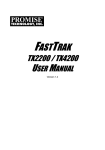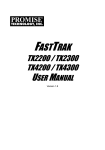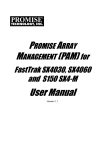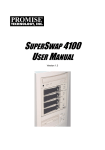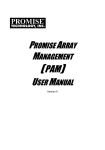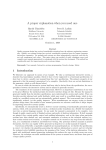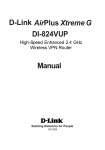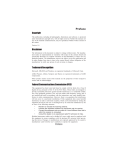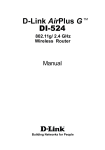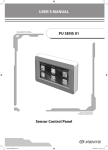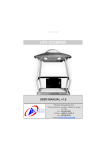Download 2_PAM for FT TX2200-4200 User
Transcript
PROMISE ARRAY MANAGEMENT (PAM) FOR FASTTRAK TX2200 / TX4200 USER MANUAL Version 1.1 PAM User Manual Copyright © 2004 Promise Technology, Inc. All Rights Reserved. Copyright by Promise Technology, Inc. (Promise Technology). No part of this manual may be reproduced or transmitted in any form without the expressed, written permission of Promise Technology. Trademarks Promise, and the Promise logo are registered in U.S. Patent and Trademark Office. All other product names mentioned herein may be trademarks or registered trademarks of their respective companies. Important data protection information You should back up all data before installing any drive controller or storage peripheral. Promise Technology is not responsible for any loss of data resulting from the use, disuse or misuse of this or any other Promise Technology product. Notice Although Promise Technology has attempted to ensure the accuracy of the content of this manual, it is possible that this document may contain technical inaccuracies, typographical, or other errors. Promise Technology assumes no liability for any error in this publication, and for damages, whether direct, indirect, incidental, consequential or otherwise, that may result from such error, including, but not limited to loss of data or profits. Promise Technology provides this publication “as is” without warranty of any kind, either express or implied, including, but not limited to implied warranties of merchantability or fitness for a particular purpose. The published information in the manual is subject to change without notice. Promise Technology reserves the right to make changes in the product design, layout, and driver revisions without notification to its users. This version of the User Manual supersedes all previous versions. Recommendations The appearance in this manual of products made by other companies, including, but not limited to software, servers and disk drives, is for the purpose of illustration and explanation only. Promise Technology does not recommend, endorse, prefer or support any product made by another manufacturer. ii Contents Chapter 1: Introduction . . . . . . . . . . . . . . . . . . . . . . . . . . . . . . . . . . . . . . . . . . . 1 PAM Components . . . . . . . . . . . . . . . . . . . . . . . . . . . . . . . . . . . . . . . . . . . . . . . . 1 How They Work Together . . . . . . . . . . . . . . . . . . . . . . . . . . . . . . . . . . . . . . . . . . 2 PAM Installation Options . . . . . . . . . . . . . . . . . . . . . . . . . . . . . . . . . . . . . . . . . . . 3 Chapter 2: Installation . . . . . . . . . . . . . . . . . . . . . . . . . . . . . . . . . . . . . . . . . . . . 7 Installation Locations . . . . . . . . . . . . . . . . . . . . . . . . . . . . . . . . . . . . . . . . . . . . . . 7 Monitoring Utility . . . . . . . . . . . . . . . . . . . . . . . . . . . . . . . . . . . . . . . . . . . . . . 7 Message Server . . . . . . . . . . . . . . . . . . . . . . . . . . . . . . . . . . . . . . . . . . . . . . 8 Message Agent . . . . . . . . . . . . . . . . . . . . . . . . . . . . . . . . . . . . . . . . . . . . . . . 9 Operating System Support . . . . . . . . . . . . . . . . . . . . . . . . . . . . . . . . . . . . . . . . . . 9 Network Requirements . . . . . . . . . . . . . . . . . . . . . . . . . . . . . . . . . . . . . . . . . . . . . 9 Installation Procedure . . . . . . . . . . . . . . . . . . . . . . . . . . . . . . . . . . . . . . . . . . . . . 10 PAM Installation . . . . . . . . . . . . . . . . . . . . . . . . . . . . . . . . . . . . . . . . . . . . . 10 Chapter 3: Initial Setup . . . . . . . . . . . . . . . . . . . . . . . . . . . . . . . . . . . . . . . . . . 15 Launch PAM . . . . . . . . . . . . . . . . . . . . . . . . . . . . . . . . . . . . . . . . . . . . . . . . . . . . 15 Local Agent Log-in . . . . . . . . . . . . . . . . . . . . . . . . . . . . . . . . . . . . . . . . . . . . . . . 17 Remote PAM Log-in . . . . . . . . . . . . . . . . . . . . . . . . . . . . . . . . . . . . . . . . . . . . . . 18 Create a New User . . . . . . . . . . . . . . . . . . . . . . . . . . . . . . . . . . . . . . . . . . . . . . . 20 Create a Logical Disk . . . . . . . . . . . . . . . . . . . . . . . . . . . . . . . . . . . . . . . . . . . . . 22 Setup Alert Notification . . . . . . . . . . . . . . . . . . . . . . . . . . . . . . . . . . . . . . . . . . . . 25 Add a User to the Recipient List . . . . . . . . . . . . . . . . . . . . . . . . . . . . . . . . . 27 Specify Alert Notification Events . . . . . . . . . . . . . . . . . . . . . . . . . . . . . . . . . 28 Chapter 4: PAM User Interface . . . . . . . . . . . . . . . . . . . . . . . . . . . . . . . . . . . . 31 Tree View . . . . . . . . . . . . . . . . . . . . . . . . . . . . . . . . . . . . . . . . . . . . . . . . . . . . . . 32 Local PAM . . . . . . . . . . . . . . . . . . . . . . . . . . . . . . . . . . . . . . . . . . . . . . . . . . 32 Remote PAM . . . . . . . . . . . . . . . . . . . . . . . . . . . . . . . . . . . . . . . . . . . . . . . . 33 Tree View and Component Specific Menus . . . . . . . . . . . . . . . . . . . . . . . . . . . . 34 Object View . . . . . . . . . . . . . . . . . . . . . . . . . . . . . . . . . . . . . . . . . . . . . . . . . . . . 35 Information View . . . . . . . . . . . . . . . . . . . . . . . . . . . . . . . . . . . . . . . . . . . . . . . . . 36 Status Bar . . . . . . . . . . . . . . . . . . . . . . . . . . . . . . . . . . . . . . . . . . . . . . . . . . . . . . 36 Pulldown Menus . . . . . . . . . . . . . . . . . . . . . . . . . . . . . . . . . . . . . . . . . . . . . . . . . 37 Toolbar . . . . . . . . . . . . . . . . . . . . . . . . . . . . . . . . . . . . . . . . . . . . . . . . . . . . . . . . 40 Popup Menus . . . . . . . . . . . . . . . . . . . . . . . . . . . . . . . . . . . . . . . . . . . . . . . . . . . 41 iii PAM User Manual Chapter 5: Monitoring and Maintenance . . . . . . . . . . . . . . . . . . . . . . . . . . . . 45 Remote PAM . . . . . . . . . . . . . . . . . . . . . . . . . . . . . . . . . . . . . . . . . . . . . . . . . . . 45 Create a RAID Server . . . . . . . . . . . . . . . . . . . . . . . . . . . . . . . . . . . . . . . . . 45 Log-in to RAID PC . . . . . . . . . . . . . . . . . . . . . . . . . . . . . . . . . . . . . . . . . . . . 47 Log-out of RAID PC . . . . . . . . . . . . . . . . . . . . . . . . . . . . . . . . . . . . . . . . . . 47 Disconnect from RAID Server . . . . . . . . . . . . . . . . . . . . . . . . . . . . . . . . . . . 47 Future Connections to RAID Server . . . . . . . . . . . . . . . . . . . . . . . . . . . . . . 48 Message Server IP Address Change . . . . . . . . . . . . . . . . . . . . . . . . . . . . . 49 Local PAM . . . . . . . . . . . . . . . . . . . . . . . . . . . . . . . . . . . . . . . . . . . . . . . . . . . . . 51 User Management . . . . . . . . . . . . . . . . . . . . . . . . . . . . . . . . . . . . . . . . . . . . . . . 52 Create a User . . . . . . . . . . . . . . . . . . . . . . . . . . . . . . . . . . . . . . . . . . . . . . . 52 Change Password . . . . . . . . . . . . . . . . . . . . . . . . . . . . . . . . . . . . . . . . . . . . 54 Change User Rights . . . . . . . . . . . . . . . . . . . . . . . . . . . . . . . . . . . . . . . . . . 55 Delete a User . . . . . . . . . . . . . . . . . . . . . . . . . . . . . . . . . . . . . . . . . . . . . . . 55 Alert Notification . . . . . . . . . . . . . . . . . . . . . . . . . . . . . . . . . . . . . . . . . . . . . . . . . 56 Setup Alert Notification . . . . . . . . . . . . . . . . . . . . . . . . . . . . . . . . . . . . . . . . 56 Add a User to the Recipient List . . . . . . . . . . . . . . . . . . . . . . . . . . . . . . . . . 58 Delete User from Recipient List . . . . . . . . . . . . . . . . . . . . . . . . . . . . . . . . . 59 Specify Alert Notification Events . . . . . . . . . . . . . . . . . . . . . . . . . . . . . . . . . 60 Controller . . . . . . . . . . . . . . . . . . . . . . . . . . . . . . . . . . . . . . . . . . . . . . . . . . . . . . 62 View Event Log . . . . . . . . . . . . . . . . . . . . . . . . . . . . . . . . . . . . . . . . . . . . . . . . . 64 Logical Disks . . . . . . . . . . . . . . . . . . . . . . . . . . . . . . . . . . . . . . . . . . . . . . . . . . . 65 Create a Logical Disk . . . . . . . . . . . . . . . . . . . . . . . . . . . . . . . . . . . . . . . . . 65 JBOD . . . . . . . . . . . . . . . . . . . . . . . . . . . . . . . . . . . . . . . . . . . . . . . . . . . . . . 68 Hot Spare Drive . . . . . . . . . . . . . . . . . . . . . . . . . . . . . . . . . . . . . . . . . . . . . . 68 Logical Disk Critical . . . . . . . . . . . . . . . . . . . . . . . . . . . . . . . . . . . . . . . . . . . 69 Logical Disk Offline . . . . . . . . . . . . . . . . . . . . . . . . . . . . . . . . . . . . . . . . . . . 70 Rebuild a Logical Disk . . . . . . . . . . . . . . . . . . . . . . . . . . . . . . . . . . . . . . . . . 72 Synchronize a Logical Disk . . . . . . . . . . . . . . . . . . . . . . . . . . . . . . . . . . . . . 75 Expand or Convert a Logical Disk . . . . . . . . . . . . . . . . . . . . . . . . . . . . . . . . 77 Delete a Logical Disk . . . . . . . . . . . . . . . . . . . . . . . . . . . . . . . . . . . . . . . . . 81 Chapter 6: RAID Concepts . . . . . . . . . . . . . . . . . . . . . . . . . . . . . . . . . . . . . . . 83 Logical Disk Terms . . . . . . . . . . . . . . . . . . . . . . . . . . . . . . . . . . . . . . . . . . . . . . . 83 RAID Levels . . . . . . . . . . . . . . . . . . . . . . . . . . . . . . . . . . . . . . . . . . . . . . . . . . . . 86 Choosing a RAID Level . . . . . . . . . . . . . . . . . . . . . . . . . . . . . . . . . . . . . . . . . . . 90 Expand or Convert a Logical Disk . . . . . . . . . . . . . . . . . . . . . . . . . . . . . . . . . . . 92 Appendix A: Partition and Format . . . . . . . . . . . . . . . . . . . . . . . . . . . . . . . . . 93 iv Chapter 1: Introduction Promise Array Management (PAM) is a software application designed specifically for monitoring and managing Promise Technology RAID products, such as the FastTrak TX2200 and TX4200 Serial ATA RAID Controller cards. Promise includes BIOS-based RAID management utilities with each of its products. PAM, however, runs over a local area network and makes possible RAID monitoring and management from any computer on the network and even over Internet. This allows your IT manager to watch your RAIDs and take care of them over the network. PAM Components There are three components to PAM. Depending on your installation, all three may be on the same workstation or work separately across your network: Monitoring Utility – The Monitoring Utility is a Graphic User Interface (GUI) that reports on the condition of the RAID logical disk. It receives and displays reports on RAID condition and operation through the Message Server. The Monitoring Utility works on any PC with a TCP/IP network connection to your RAID. When installed on the computer that operates the RAID, the Monitoring Utility also provides a complete set of RAID management tools. Message Server – The Message Server is the link connecting a PC with the Monitoring Utility. Normally, the Message Server runs on a network file server. But it can also run on the PC controlling the RAID. Message Agent – The Message Agent runs on the PC that controls the RAID, called the “RAID PC”. It directly monitors the RAID and sends messages through the Message Server to all PCs running the Monitoring Utility. 1 PAM User Manual How They Work Together The Promise Array Management (PAM) software provides and easy way to set up, monitor, modify and repair your RAID. PAM works with the Promise FastTrak TX2200 and TX4200 Serial ATA RAID Controller cards. PAM watches the RAID and when significant events happen, or it discovers a problem, the Message Agent sends a warning to the Message Server. The Message Server passes the warning along to all PCs running the Monitoring Utility. Warnings appear on the PC in the form of email messages and popup alerts. You can select either one or both. You can also select which events and problems PAM will report. A major benefit of PAM is that it runs over a TCP/IP network. This enables remote monitoring of your RAIDs, including offsite monitoring over an Internet connection. Once you become aware of a problem, go to the PC that controls the RAID, called the “RAID PC” to take corrective action. If you have more than one RAID PC on your network, PAM will indicate which one has the problem. PAM allows only monitoring access through the network. Management access occurs only at the RAID PC. 2 Chapter 1: Introduction PAM Installation Options 1. Following are some examples of ways you can incorporate PAM into your network and RAID systems. The Internet Home-based PC + Monitoring Utility Laptop computer + Monitoring Utility Router & Firewall Networked PC + Monitoring Utility PC + FastTrak S150 TX4 + Message Agent Network File Server + Message Server PC + FastTrak TX4200 + Internal RAID logical disk + Message Agent PC + FastTrak TX2200 + Message Agent Figure 1. LAN and Internet connections. In the example above, there are three PCs with FastTrak cards connected to the company’s LAN. The PAM Message Agent runs on each of the PCs with a FastTrak card. The PAM Message Server runs on the company’s file server. The PAM Monitoring Utility runs on networked PCs and also on remote PCs connecting to the company network through the Internet. With this arrangement, 3 PAM User Manual you can monitor RAID condition and activity from offsite, such as a hotel room or home office. Networked PC + Monitoring Utility PC + FastTrak TX2200 + Message Agent Networked PC + Monitoring Utility + Message Server PC PC + FastTrak TX4200 + FastTrak S150 TX2plus + Internal RAID logical disk + Message Agent + Message Agent Figure 2. Company LAN without a File Server In the above example, there are three PCs with FastTrak cards connected to the company’s LAN, the same as before. But this network has no file server, so the PAM Message Server runs on one of the networked PCs. PAM Monitoring Utility runs on both networked PCs. If this LAN were upgraded with a suitable router and an Internet connection, you could set up offsite monitoring. 4 Chapter 1: Introduction PC + FastTrak TX2200 + Monitoring Utility + Message Agent PC + FastTrak TX4200 + Internal RAID logical disk + Monitoring Utility + Message Agent Figure 3. PCs with Internal RAID. Promise’s FastTrak card is designed to setup and control a RAID within the PC’s enclosure. They have the same need of monitoring and management as an external RAID subsystem. All three PAM components run on the PC itself. Important This manual accompanies a special version of PAM optimized to run with the FastTrak TX2200 and TX4200. Other versions of PAM will run reliably on the Promise RAID product with which they ship. They will also run reliably on several Promise RAID products in normal use. However, they may not perform adequately with a FastTrak TX2200 and TX4200. 5 PAM User Manual 6 Chapter 2: Installation To install Promise Array Management (PAM) is an uncomplicated procedure, once you understand your systems and how you want to use PAM. The purpose of this Chapter is to help you plan and carry out your installation of PAM. By way of review, PAM consists of three components: • Monitoring Utility • Message Server • Message Agent These were described in the previous chapter. Before proceeding with the installation, you must know which component goes where. If you plan to run PAM over a network, you must know the IP addresses of each computer on the network that will be involved in your RAID monitoring and management activity. Installation Locations In the table below are, possible locations for each of the three PAM components. Monitoring Utility Message Server Internet-connected PC • Network PC • • Network File Server • • RAID PC • • Message Agent • Monitoring Utility The Monitoring Utility installs on any computer you will use to monitor and manage the RAIDs. If your RAID runs without a network connection, install it on the RAID PC with the rest of the PAM components. If your RAIDs are networked, you can install the Monitoring Utility on any computer connected to the network. If your company has networked RAIDs and Internet access, you may choose to install the Monitoring Utility on a laptop or home-based PC for dial-in remote access. 7 PAM User Manual Limit your installation to the computers of RAID users and your IT administrator. PAM features password protection to further limit access and provide security of your data. The Internet Home-based PC + Monitoring Utility Laptop computer + Monitoring Utility Router & Firewall Networked PC + Monitoring Utility PC + FastTrak S150 TX4 + Message Agent Network File Server + Message Server PC + FastTrak TX4200 + Internal RAID logical disk + Message Agent PC + FastTrak TX2200 + Message Agent Figure 1. Networked RAID has many installation options. Message Server The Message Server is required if your RAID PC connects to a network. If you want run PAM over a network, install the Message Server on one of your networked computers including a file server, a networked PC or the RAID PC. 8 Chapter 2: Installation Only one installation of the Message Server is required for PAM to work over a network. You may install Message Server on more than one network PC or file server, but PAM’s network configuration will only use one of them, thus any additional installations are useless. Do not install the Message Server on any PC that may be disconnected from the network, such as a laptop or a computer that connects via the Internet. Not only will a disconnect cause PAM to fail, but reconnecting again may involve timeconsuming network configuration. Network configuration is discussed later in this chapter. Message Agent The Message Agent installs on the RAID PC, whether your RAID is networked or not. In order for PAM to monitor and manage a RAID, it must have Message Agent installed. If you have more than one PAM-compatible RAID PC on your network, install a copy of Message Agent on each one of them. Operating System Support PAM is a utility designed to run on top of previously installed Promise FastTrak card. Generally, if your PC runs the FastTrak card properly, it will run PAM also. Promise Technology recommends Windows 2000, XP Professional or Server 2003 to take full advantage of all the features of PAM. In some cases, you can run PAM on other Windows operating systems. This becomes an issue when running PAM over a network where there are PCs with different operating systems. Network Requirements If you plan to install PAM on a network be sure all the hosts and servers are connected and running. That is, each of the PCs, RAIDs and Servers must have a working network connection before you install PAM. In order for PAM to be configured over a network, you must know the IP (network) address of the RAID PC(s) in your system. The Message Server uses IP addresses to communicate with the Message Agent on the RAID PCs and the Monitoring Utility on the network PCs. 9 PAM User Manual Installation Procedure Before you start… If you are installing PAM to run over a network, determine the computers and servers onto which you will install PAM. Obtain the IP addresses of all RAID PCs where PAM will be installed. PAM Installation With that information ready, follow these steps to install PAM on each computer or server: 1. Boot the PC/server and launch Windows. 2. If the computer is already running, exit all programs. 3. Insert FastTrak CD into your CD-ROM drive. 4. Open the CD and locate the PAM folder. 5. Inside the PAM folder, look for the PAM Setup Installer icon (right). 6. Double-click the icon to run the installer. The opening screen appears. 7. Click Next or press Enter to continue. 10 Chapter 2: Installation 8. When the License Agreement appears, click the “I accept” radio button to agree to the terms and continue the installation. If you click “I do not accept,” PAM Setup will exit. 9. In the Setup Type dialog box, make your choice between Typical (Recommended) and Custom installation. 11 PAM User Manual Use the Custom installation to change install locations or to deselect individual components. For example, use Custom to install only the Message Server onto your network fileserver. Click Next or press Enter to continue. 10. In the Ready to Install dialog box, click Install or press Enter to continue. 12 Chapter 2: Installation 11. When the Add User Account dialog box appears, you can accept the default name or enter a new one in the Name field. Enter your password in the Password and Confirm Password fields. A password is not required. When you are done, click Next or press Enter to continue. Note If you are only installing the Message Server, this dialog box does not appear. page 15 12. When the Install Complete dialog box appears, you have the option to: • Create PAM shortcuts on your Desktop • Register PAM online Both of these options are recommended. Click Finish or press Enter when you are done. This completes the PAM installation. Go on to Chapter 3: Initial Setup on page 15. 13 PAM User Manual 14 Chapter 3: Initial Setup After you have completed installation, you must setup your PAM Monitoring Utility to work with your RAID. Launch PAM To Start PAM, click on a Desktop icon or go to Start > Programs > Promise Array Management and select: Local PAM – Use to monitor and manage the FastTrak Controller in your PC Remote PAM – Use to monitor FastTrak Controllers over your network Note If you only installed the Message Server, this shortcut does not appear. The Message Server works only through network connections and has no user interface. Go to the RAID PC or a Networked PC to setup PAM. 15 PAM User Manual The Monitor window (above) is the user interface for PAM. It has three views: Tree View – Displays the elements of your RAID system. It works like Windows Explorer with hierarchical menus. You can expand individual items to see their components. Object View – Displays icons representing the devices below the highlighted device in the Tree View. Information View – Displays information on the item highlighted in the Tree View. This may include text boxes, list boxes, fields and buttons. It varies with the item you select in Tree View. 16 Chapter 3: Initial Setup Local Agent Log-in The Message Server relays data and commands between the Monitoring Utility on this computer and the Message Agent on the RAID PCLaunch Local PAM. When the PAM user interface appears: 1. Right click on the RAID Machine icon in Tree View. Select Login from the popup menu. The Login dialog box appears. 2. In the Login dialog box, type your Username and Password, and click OK. Initially, administrator is the only user. Use the administrator’s password selected during installation. 17 PAM User Manual Remote PAM Log-in Remote PAM works over your network. Therefore it requires additional steps the first time you log on. Launch Remote PAM. When the PAM user interface appears: 1. Right-click on the My Console icon and: • Select New > Server from the popup menu. • Click the New Server icon in the Toolbar. A RAID Server icon appears. 2. Click on the RAID Server icon. In Information View, type in the IP address of the computer where the Message Server Software is installed. If the Message Server software in installed on the monitoring PC (the PC you are now working on), you can use the default 127.0.0.1 IP address. 18 Chapter 3: Initial Setup 3. Click Submit. A list of networked RAID PCs appears as shown below. 4. Right-click on the RAID Machine icon in Tree View. Select Login from the popup menu. The Login dialog box appears. 5. In the Login dialog box, type your Username and Password, and click OK. Initially, administrator is the only user. Use the administrator’s password selected during installation. If you want to log in to another user’s RAID PC, obtain the User name and Password, if necessary. 19 PAM User Manual Create a New User With the Message Agent accessed, you can add a new user. The Administrator is created by default. You must create additional users manually.The administrator is created by default. You must create additional users manually. 1. Do one of the following: • Right click on the User Management from the popup menu. A new User • 2. Or select the User Management button on the Toolbar. icon and select New > User icon appears. icon and click the Add User Right-click on the User icon and select New > User from the popup menu (right). A new user icon appearsto display the User Information View. 20 Chapter 3: Initial Setup The User Information View displays a request for new user identification and access rights. Rights Definitions Creation Allows you to create and delete logical disks, rebuild and synchronize logical disks, and make general settings Maintenance Allows you to rebuild and synchronize logical disks, and make general settings User Account Allows user to modify his/her own rights and to create and delete other usersyou to add and delete user accounts and change your password Every User has at least one of these three Rights and can change his/her own password. The Administrator can assign more or fewer rights to other Users but cannot change their passwords. 3. Type a User name and Password in their respective fields. Check all the appropriate boxes to set access rights. Click the Submit button when you are done. The new user's name appears on Tree View. 21 PAM User Manual Create a Logical Disk The available RAID selection depends on the number of disk drives available. The table below lists the RAID Levels available with FastTrak TX Series and the number of drives required. Click the + to the left of each Channel to see the disk drive. If there is no +, the Channel does not recognize a disk drive. The available RAID selection depends on the number of disk drives available. The table below lists the options. See page 83 for a more detailed description. 1. RAID Level Name Minimum drives Maximum drives 0 Stripe 1 4 1 Mirror 2 2 10 Mirror + Stripe 4 4 In Tree View, click the + to the left of the Controller Logical Disk View 2. icon to see the icon. Right-click on the Logical Disk View from the popup menu. OR Click on the Logical Disk View View… icon and select Create Logical Disk icon and look in the Information …and click the Create Logical Disk button. The Logical Disk Creation Setting box appears. 22 Chapter 3: Initial Setup 3. In the Logical Disk Creation Setting box: • Type in a name for your logical disk • Select the RAID Level from the dropdown menu • Set the Stripe Block Size (see below) • Highlight the disk drives to add to the logical disk • Check to enable Gigabyte Boundary, as desired (see below) Stripe Block Size – For RAID 0 and RAID 10 logical disks, you can manually select the stripe block size, either 32, 64 or 128 KB. The size selected affects how FastTrak send and receives data blocks to and from the drives. In general, a larger block size is better when handling large data transfers (such as A/V editing and graphics) while a smaller size is better when handling email and other common server data. The default is 64KB. When in doubt, use the default value. Gigabyte Boundary – For RAID 1 and RAID 10 logical disks. It rounds the size of the logical disk down to the nearest whole gigabyte. It allows you to install a slightly smaller (within 1 GB) replacement drive, should the need arise. To enable Gigabyte Boundary, check the box. 4. Click the Create button when you are done. 23 PAM User Manual PAM reminds you that by creating this logical drive, any data on the selected disk drives will be deleted. 5. Click OK or press Enter to continue. The new logical disk appears in Tree View and Information View (above). Note Before you can use your new logical disk, you must partition and format the logical disk using your PC’s operating system. See page 93. 24 Chapter 3: Initial Setup Setup Alert Notification PAM alerts you to the problems and processes happening to your RAID through email and popup messages. These steps describe how to setup the email function. 1. Click on the RAID Machine Information View. icon. Information for the RAID PC appears in 2. Be sure the Enable NT system event log checkbox is checked. 3. To reduce the volume of repeated messages, check the Anti-SPAM checkbox and set an acceptable time interval in hours. 4. Click on the Email alert on error box, if it is not already checked. 5. In the SMTP server field, type in the SMTP address for your mail server. 6. The default is No Authentication Method. If you want an Authentication Method, in the dropdown menu choose from: • CRAM-MD5 • Authorized Login • Plain Login 7. Type in a User Name and Password in the fields provided. 8. Click the Change button to update your configuration. 25 PAM User Manual 9. Scroll down to the Email Sender and Recipients box. 10. In the Email ID of Alert Sender field, type in the email address of this computer. 11. This address will appear in the From field of the email alerts. Recipients may reply to this address, if it is valid. 12. Click the Change button to update your configuration. 26 Chapter 3: Initial Setup Add a User to the Recipient List After you have setup email alert notification, you must specify who shall receive the alerts. 1. Click on the RAID Machine message recipient. icon to which you wish to add an email alert 2. In the Alert Recipients Email Address field, type in the email address of the user who you wish to receive alerts. 3. Click the Add button when you are done. The names appear in the Current Recipients window. 4. Repeat Step 2 until all addresses have been added. 27 PAM User Manual Specify Alert Notification Events PAM can be configured to report a variety of alerts, by email, popup message or both. This section describes how to tell PAM what to report and which method to use. 1. Click on the RAID System to modify. icon whose alert notification events you wish 2. The Event Alert Setting box has dropdown manus to help you select Alert Events quickly. To select Events, click on Options and choose Select. 3. Click on Message Type and choose message delivery by E-Mail, by Popup, by All (both) or None. 28 Chapter 3: Initial Setup 4. Click on the Severity Level and choose Error, Warning, Information, All or None. Following is a list of Events. The term Array refers to a logical disk. Information Events Warning Events Disk Plug In Disk Media Error Disk Access Retry Disk S.M.A.R.T. Failed JBOD to Spare Disk ECC Error Spare to JBOD Disk Time Out Controller Create Array Inconsistent Table Exceed Threshold Array Rebuild Started Read Check Table Exceed Threshold Array Auto Rebuild Started Disk CRC Error Array Rebuild Resumed Array Critical Array Rebuild Completed Controller Delete Array Array Synchronization Started Array Rebuild Paused Array Synchronization Aborted Array Expansion/Conversion Paused Array Synchronization Paused Enclosure Over Temperature Array Synchronization Resumed Enclosure Fan Stop Array Synchronization Completed Enclosure 12V Error Array Expansion/Conversion Started Enclosure 5V Error Array Auto Expansion/Conversion Started Array Expansion/Conversion Completed Array Expansion/Conversion Resumed Enclosure 3.3V Error Error Events Disk Offline Array Media Error Inconsistent Table Full Read Check Table Full Array Offline Array Rebuild Failed Array Synchronization Failed Array Synchronization Comparison Error Array Expansion/Conversion Failed 5. To select an individual Event, click in the E-Mail and Popup columns to toggle between Yes and No. 6. When you are finished, click the Apply button. 29 PAM User Manual 30 Chapter 4: PAM User Interface This chapter describes PAM’s Graphic User Interface (GUI). You should understand that PAM is software running on top of the Promise RAID BIOS and other applications that came with your Promise RAID product. PAM adds a graphic user interface to make RAID management functions easier to understand and perform. The PAM Window (above) has three views: Tree View, Object View and Information View. These views are explained on the following pages. 31 PAM User Manual Tree View Local PAM The Tree View displays all of the elements of your RAID system. Use it to navigate to specific components. 32 Chapter 4: PAM User Interface Remote PAM Remote PAM adds a RAID Server icon to connect with the Message Server PC in order to monitor logical disks over a network. Normally, the Tree View is present. To close it, right-click on any object and select Hide Pane from the popup menu. To open it again, go to View menu and select Outline. 33 PAM User Manual Tree View and Component Specific Menus In PAM, like most Windows applications, you can access the various commands and functions by opening dropdown menus and clicking on icons. Each time you click on a component in Tree View, PAM’s menu bar also displays that component’s dropdown menu. Below are some examples. Rather than access the menu bar, you can right click on the icon of the component you are working with. The menu bar and popup menus for Tree View items are identical. 34 Chapter 4: PAM User Interface Object View Object View is visible whenever the Tree View is visible. The items appearing in Object View are determined by which component you select in Tree View. In the example below, we selected a Controller icon in Tree View. As a result, you see the components of that Controller, in this case, the Disk View, which shows the disk drives attached to the Controller, and the Logical Disk View, which shows the logical disks created under this Controller. This feature makes it easy to find an individual component as well as see what items are assigned to higher level components. Double-click on these items to see their components in Object View and their configuration in Information View. 35 PAM User Manual Information View Information View, like Object View, changes its content depending on which item you select in Tree View. The difference is that you use Information View to obtain data, input settings and information. The example above shows what Information View displays when you click on the Logical Disk View icon. Status Bar The PAM Status Bar is the same as other Windows applications. It indicates such things as the selected RAID is rebuilding, and the current user is the Administrator (below). Normally the Status Bar is visible. To show or hide the Status Bar, go to the View menu and check or uncheck Status Bar. 36 Chapter 4: PAM User Interface Pulldown Menus The left-most Pulldown Menu changes according to which component is selected in the Tree View. This menu can be the Main, My Console, Server, RAID Machine, RAID System or Maintenance. The functions of each menu are described below. Main Menu When no item in Tree View is selected, the left-most menu item is Main. Its only function is Exit, which quits the PAM application. My Console Menu When the My Console functions include: icon is selected, the My Console menu appears. Its • Create a new Server • Screen refresh • Rename the My Console icon • Exit PAM Server Menu The Server menu appears when the RAID Server icon is selected. This menu applies only to Remote PAM. Its functions include: • Modify the connection • Delete the connection • Connect • Disconnect • Screen refresh • Rename the Server icon • Exit PAM 37 PAM User Manual RAID Machine Menu When the RAID Machine Its functions include: icon is selected, the RAID Machine menu appears. • Login • Logout • Screen refresh • Rename the RAID Machine icon • Exit PAM RAID System Menu The RAID System menu appears with the RAID System functions include: • Screen refresh • Rename the RAID System icon • Exit PAM icon is selected. Its Maintenance Menu When the Controller Controller functions: icon is selected, the Maintenance menu displays • Read Events in the Event Viewer • Clear Events from the Event Viewer • Toggle the Beeper on and off • Refresh the screen • Rename the Controller icon • Exit PAM When the Logical Disk View Controller functions: icon is selected, the Maintenance menu displays • Create a logical disk • Refresh the screen • Rename the Logical Disk icon 38 Chapter 4: PAM User Interface View Menu The View menu is always the same. It displays or hides three items: • Toolbar • Status Bar • Outline (Tree View ) Check to display or uncheck to hide each one as you prefer. Connection Menu The Connection menu is always the same. It deals with server connections. Use it to: • Create a new Message Server • Connect to a RAID Server • Disconnect from a RAID server Preference Menu The Preference menu is always the same. It allows you to start PAM automatically when your PC boots. • Run on Startup Check to enable or uncheck to disable this feature. If you are using PAM for remote monitoring, running PAM automatically is a good idea. This way, your PC will be connected to the RAID and you will receive all the alerts messages you have specified. Help Menu The Help menu is always the same. Under Help, PAM has: • Full online Help file • Auto Demo display • About page with PAM information 39 PAM User Manual Toolbar The Toolbar is a series of buttons that are shortcuts to performing specific tasks. You will never see all buttons active as in the example below. They become active when you click on specific system components in Tree View. Only the tool buttons pertaining to that component are active. Most of these functions require User Account Rights. These are specified when a User is added or modified. Following is a description of the Toolbar buttons: New Server. Available when you select the MyConsole Remote PAM. Creates a new Message Server. icon in Connect. Available when you select the Message Server icon in Remote PAM. Initiates a connection with the RAID Server. Disconnect. Available when you select a Message Server icon. Disconnects from the RAID Server. Used when you want to shut down a RAID server for repair. Delete User. Available when you select a User the user from monitoring and alert access. icon. Deletes New User. Available when you select the User Management icon. About. Brings up the information about this version of PAM. Help. Always available. Brings up the Online Help. 40 Chapter 4: PAM User Interface Popup Menus In addition to the commands in the dropdown menus, there is a corresponding set of commands you can access via popup menus. In a popup menu, you can use any of the commands that are in black. You will notice that some functions are grayed out, meaning that you cannot use them. Many functions require that you have User Account Rights to perform them. MyConsole Icon Right-click on the MyConsole • New Server (Remote PAM) • Screen refresh icon to access the following commands: Message Server Icon Right-click on the Message Server • Modify the connection • Delete the connection • Connect • Disconnect • Screen refresh icon to access the following commands: RAID Machine Icon Right-click on the RAID Machine • Login • Logout • Screen refresh • Rename the RAID Machine icon icon to access the following commands: RAID System Icon The RAID System icon represents the FastTrak TXII Family of RAID Controller cards. There is one command for this item: • Screen refresh 41 PAM User Manual Controller Icon Right-click on the Controller icon to access the following commands: • Read Events in the Event Viewer • Clear Events from the Event Viewer • Toggle the Beeper on and off • Refresh the screen Disk View Icon The Disk View icon represents an individual channel on the FastTrak Controller card. There is one command for this item. • Refresh the screen Disk Icon Right-click on the Disk icon of an unassigned drive or the Disk assigned drive to access the following command: • icon of an Refresh the screen Logical Disk View Icon Right-click on the Logical Disk View controller. • Create a logical disk • Refresh the screen icon to see all of the logical disks on this Logical Disk Icon Right-click on the Logical Disk • icon to access the following commands: Synchronize this logical disk • Delete this logical disk • Pause synchronization/rebuild/expand/convert • Continue synchronization/rebuild/expand/convert • Refresh the screen • Rename the Logical Disk icon 42 Chapter 4: PAM User Interface User Management Icon Right-click on the User Management • Create a New User • Refresh the screen icon to access the following commands: User Icon Right-click the User icon • Delete this User • Refresh the screen to access the following commands: 43 PAM User Manual 44 Chapter 5: Monitoring and Maintenance This chapter describes using PAM to monitor and manage your RAID system. The chapter is divided into sections for major PAM componentsas follows: • Remote PAM (below) • Local PAM (page 51) • User Management (page 52) • Alert Notification (page 56) • Controller (page 62) • Event Log (page 64) • Logical Disks (Arrays) (page 65) Remote PAM Create a RAID Server Remote PAM works over your network. Therefore it requires additional steps the first time you log on. Launch Remote PAM. When the PAM user interface appears: 1. Right-click on the My Console icon and: • Select New > Server from the popup menu. • Click the New Server icon in the Toolbar. 45 PAM User Manual A RAID Server icon appears. 2. Click on the RAID Server icon. In Information View, type in the IP address of the computer where the Message Server Software is installed. If the Message Server software in installed on the monitoring PC (the PC you are now working on), you can use the default 127.0.0.1 IP address. 3. Click Submit. A list of networked RAID PCs appears as shown below. 46 Chapter 5: Monitoring and Maintenence Log-in to RAID PC 1. Right-click on the RAID Machine icon in Tree View. Select Login from the popup menu. The Login dialog box appears. 2. In the Login dialog box, type your Username and Password, and click OK. Initially, administrator is the only user. Use the administrator’s password selected during installation. If you want to log in to another user’s RAID PC, obtain the User name and Password, if necessary. Log-out of RAID PC You can log out of one RAID PC while remaining connected to others on the network. Right-click on the RAID Machine icon of the PC you want to disconnect and select Logout from the popup menu. Disconnect from RAID Server Logout of the RAID Server effectively logs you out of all RAID PCs using that network connection. To disconnect from the network: • Right-click on a RAID Server menu. icon and select Disconnect from the popup • Or right-click on the RAID Server in the Toolbar. 47 icon and click the Disconnect icon PAM User Manual Future Connections to RAID Server The RAID Server remains under the MyConsole icon until deleted. It continues to work as long as the IP address is correct. To make a connection with an existing RAID Server: • Right-click on a RAID Server menu. icon and select Connect from the popup • Or right-click on the RAID Server the Toolbar. icon and click the Connect The Login list of networked RAID PCs appears as before. 48 icon in Chapter 5: Monitoring and Maintenence Message Server IP Address Change If the IP address changes for the computer where the Message Server software is installed, an existing RAID Server with the old address will no longer work. 1. Right-click on a RAID Server menu. icon and select Delete from the popup 2. Click OK in the confirmation dialog box. 3. Right-click on the My Console icon and: • Select New > Server from the popup menu. • Click the New Server icon in the Toolbar. 49 PAM User Manual A RAID Server icon appears.. 4. Click on the RAID Server icon. In Information View, type in the IP address of the computer where the Message Server Software is installed. If the Message Server software in installed on the monitoring PC (the PC you are now working on), you can use the default 127.0.0.1 IP address. 5. Click Submit. A list of networked RAID PCs appears as shown below. 50 Chapter 5: Monitoring and Maintenence Local PAM Log-in Launch Local PAM. When the PAM user interface appears: 1. Right click on the RAID Machine icon in Tree View. Select Login from the popup menu. The Login dialog box appears. 2. In the Login dialog box, type your Username and Password, and click OK. Initially, administrator is the only user. Use the administrator’s password selected during installation. Log-out To log-out of a Local PAM, right-click on the RAID Machine Logout from the popup menu. 51 icon and select PAM User Manual User Management Create a User With the Message Agent accessed, you can add a new user. The Administrator is created by default. You must create additional users manually.The administrator is created by default. You must create additional users manually. 1. Do one of the following: • Right click on the User Management from the popup menu. A new User • 2. Or select the User Management button on the Toolbar. icon and select New > User icon appears. icon and click the Add User Right-click on the User icon and select New > User from the popup menu (right). A new user icon appearsto display the User Information View.. 52 Chapter 5: Monitoring and Maintenence The User Information View displays a request for new user identification and access rights. Rights Definitions Creation Allows you to create and delete logical disks, rebuild and synchronize logical disks, and make general settings Maintenance Allows you to rebuild and synchronize logical disks, and make general settings User Account Allows user to modify his/her own rights and to create and delete other usersyou to add and delete user accounts and change your password Every User has at least one of these three Rights and can change his/her own password. The Administrator can assign more or fewer rights to other Users but cannot change their passwords. 3. Type a User name and Password in their respective fields. Check all the appropriate boxes to set access rights. Click the ComSubmit button when you are done. The new user's name appears on Tree View. 53 PAM User Manual Change Password Every User can change his/her own password. The Administrator cannot change other Users' passwords. 1. Log-in to PAM under the User Name whose Password you want to change. 2. Click on the 3. In Information View, type in a new Password in the two Password fields. 4. Click the Submit button when you are done. icon of the User whose Password you want to change. 54 Chapter 5: Monitoring and Maintenence Change User Rights The Administrator can change any User’s Rights. Other Users cannot change their Rights. 1. Log into PAM as the Administrator. 2. Click on the 3. In Information View, check or uncheck Rights options as desired (above). 4. Click the Submit button when you are done. icon of the User whose Rights you want to change. Delete a User 1. Log into PAM as the Administrator. 2. Right-click on the icon of the User you wish to delete and select Delete from the popup menu. 3. In the confirmation dialog box, click OK. Note PAM will always keep one user account with access rights, typically the Administrator. This action protects you from being locked out of the system. Another way to delete a User: Select the User’s the Delete User button in the Toolbar. 55 icon in Tree View then click PAM User Manual Alert Notification Setup Alert Notification PAM alerts you to the problems and processes happening to your RAID through email and popup messages. These steps describe how to setup the email function. 1. Click on the RAID Machine Information View. icon. Information for the RAID PC appears in 2. Be sure the Enable NT system event log checkbox is checked. 3. To reduce the volume of repeated messages, check the Anti-SPAM checkbox and set an acceptable time interval in hours. 4. Click on the Email alert on error box, if it is not already checked. 5. In the SMTP server field, type in the SMTP address for your mail server. 6. The default is No Authentication Method. If you want an Authentication Method, in the dropdown menu choose from: • CRAM-MD5 • Authorized Login • Plain Login 7. Type in a User Name and Password in the fields provided. 8. Click the Change button to update your configuration. 56 Chapter 5: Monitoring and Maintenence 9. Scroll down to the Email Sender and Recipients box. 10. In the Email ID of Alert Sender field, type in the email address of this computer. 11. This address will appear in the From field of the email alerts. Recipients may reply to this address, if it is valid. 12. Click the Change button to update your configuration. 57 PAM User Manual Add a User to the Recipient List After you have setup email alert notification, you must specify who shall receive the alerts. 1. Click on the RAID Machine message recipient. icon to which you wish to add an email alert 2. In the Alert Recipients Email Address field, type in the email address of the user who you wish to receive alerts. 3. Click the Add button when you are done. The names appear in the Current Recipients window. 4. Repeat Step 2 until all addresses have been added. 58 Chapter 5: Monitoring and Maintenence Delete User from Recipient List To remove a recipient from the Email Address List, do the following: 1. Click on the RAID Machine alert message recipient. icon from which you wish to delete an email The Current Recipients window appears in the Information View. 2. Select the recipient you wish to delete 3. Click the Remove button or press the Delete key to remove the address from the list. 59 PAM User Manual Specify Alert Notification Events PAM can be configured to report a variety of alerts, by email, popup message or both. This section describes how to tell PAM what to report and which method to use. 1. Click on the RAID System to modify. icon whose alert notification events you wish 2. The Event Alert Setting box has dropdown manus to help you select Alert Events quickly. To select Events, click on Options and choose Select. 3. Click on Message Type and choose message delivery by E-Mail, by Popup, by All (both) or None. 60 Chapter 5: Monitoring and Maintenence 4. Click on the Severity Level and choose Error, Warning, Information, All or None. Following is a list of Events. The term Array refers to a logical disk. Information Events Warning Events Disk Plug In Disk Media Error Disk Access Retry Disk S.M.A.R.T. Failed JBOD to Spare Disk ECC Error Spare to JBOD Disk Time Out Controller Create Array Inconsistent Table Exceed Threshold Array Rebuild Started Read Check Table Exceed Threshold Array Auto Rebuild Started Disk CRC Error Array Rebuild Resumed Array Critical Array Rebuild Completed Controller Delete Array Array Synchronization Started Array Rebuild Paused Array Synchronization Aborted Array Expansion/Conversion Paused Array Synchronization Paused Enclosure Over Temperature Array Synchronization Resumed Enclosure Fan Stop Array Synchronization Completed Enclosure 12V Error Array Expansion/Conversion Started Enclosure 5V Error Array Auto Expansion/Conversion Started Array Expansion/Conversion Completed Array Expansion/Conversion Resumed Enclosure 3.3V Error Error Events Disk Offline Array Media Error Inconsistent Table Full Read Check Table Full Array Offline Array Rebuild Failed Array Synchronization Failed Array Synchronization Comparison Error Array Expansion/Conversion Failed 5. To select an individual Event, click in the E-Mail and Popup columns to toggle between Yes and No. 6. When you are finished, click the Apply button. 61 PAM User Manual Controller Options The Controller has system information and settings several important features. Click on the Controller icon in Tree View to see the Options in Information View. To return to the previous settings, click Reset. To Apply the changes you have made, click Submit.. System Information This describes the Controller type, in this case a FastTrak TX4200, and the FastTrak driver version. This information may be helpful when upgrading your FastTrak or troubleshooting the PC. Disk Parameters Check the respective boxes to enable these features: SMART Check – SMART, an acronym for Self-Monitoring Analysis and Reporting Technology, is a feature of the disk drive software. It monitors the 62 Chapter 5: Monitoring and Maintenence internal performance of the drive and reports to the PC when it finds a potential failure. SMART warns you of a developing drive failure so you can replace the drive before it actually fails. Disable Hard Disk Write Cache – Disables the Write Cache on the hard disk drives. This action will reduce performance. Enable NCQ/TCQ – Enables the FastTrak controller to work with the NCQ or TCQ features of disk drives. Native Command Queuing (NCQ) is a feature of SATA 1.0 Extensions compliant disk drives that allows them to reorder up to 32 commands they receive for optimal read/write performance. Tagged Command Queuing (TCQ) is the capability to reorder up to 128 read/ write commands based on position of data under read/write heads, to increase read/write performance. A SCSI feature. Maintenance Setting Check the respective boxes to enable these features: Disable Hot Spare/Auto Rebuild – Disables automatic rebuilding using a hot spare drive or a newly installed replacement drive. This feature requires a FastTrak TX4200 controller, a RAID 1 (mirrored) logical disk and a spare disk drive of adequate capacity. With this option checked, you must initiate rebuilding manually. Maintenance Rate – Allocates system resources between rebuilding the Following is a list of Events. The term Array refers to a logical disk and responding to read/write commands from the computer system. A High setting assigns most of the system resources to a rebuild or synchronization of the Following is a list of Events. The term Array refers to a logical disk.. The process will finished sooner but read/write requests are handled slower. A Low setting assigns most of the system resources to handling read/write requests. Read/write requests are handled at nearly normal speed while the rebuild or synchronization takes longer. See page 72 for more information on the rebuilding process. Maintenance Error Handling Policy – On Disk Error When the FastTrak controller discovers a disk error during synchronization, this setting directs the controller to abort synchronization, skip over the disk error or repair the disk error. 1. Make the changes you want to the Controller settings. 2. When you are finished, click the Submit button. 63 PAM User Manual View Event Log The Controller’s Memory Buffer records all the events that happen on the RAID, classified as Errors, Warnings and Information. These are very useful for diagnosing and solving problems on your system. To see the Event Log, right-click on the Controller icon select Read Events from the popup menu. in Tree View and In the Event Viewer, you can view the events, make a permanent record by saving them to a file, and clear the events from the Viewer. You can also clear the events using the popup menu in Tree View. Note that the collecting and reporting of these Events is independent from the Alert Notification preferences set for the RAID System. 64 Chapter 5: Monitoring and Maintenence Logical Disks • Create a Logical Disk (below) • JBOD (page 68) • Hot Spare Drive (page 68) • Logical Disk Critical (page 69) • Logical Disk Offline (page 70) • Rebuild a Logical Disk (page 72) • Sychronize a Logical Disk (page 75) • Expand or Convert a Logical Disk (page 77) • Delete a Logical Disk (page 81) Create a Logical Disk The available RAID selection depends on the number of disk drives available. The table below lists the RAID Levels available with FastTrak Serial ATA RAID Controller and the number of drives required. Click the + to the left of each Channel to see the disk drive. If there is no +, the Channel does not recognize a disk drive. The available RAID selection depends on the number of disk drives available. The table below lists the options. See page 83 for a more detailed description. Name Minimum drives Maximum drives 0 Stripe 1 4 1 Mirror 2 2 10 Mirror + Stripe 4 4 RAID Level Although JBOD is technically not a RAID level, the JBOD option is included in the RAID Level menu on the Logical Disk Creation Setting. JBODs are single drives only. See page 68 for more information. 1. In Tree View, click the + to the left of the Controller Logical Disk View icon. 65 icon to see the PAM User Manual 2. Right-click on the Logical Disk View from the popup menu. OR Click on the Logical Disk View View… icon and select Create Logical Disk icon and look in the Information …and click the Create Logical Disk button. The Logical Disk Creation Setting box appears. 3. In the Logical Disk Creation Setting box: • Type in a name for your logical disk • Select the RAID Level from the dropdown menu • Set the Stripe Block Size (see below) • Highlight the disk drives to add to the logical disk • Check to enable Gigabyte Boundary, as desired (see below) 66 Chapter 5: Monitoring and Maintenence Stripe Block Size – For RAID 0 and RAID 10 logical disks, you can manually select the stripe block size, either 32, 64 or 128 KB. The size selected affects how FastTrak sends and receives data blocks to and from the drives. In general, a larger block size is better when handling large data transfers (such as A/V editing and graphics) while a smaller size is better when handling email and other common server data. The default is 64KB. When in doubt, use the default value. Gigabyte Boundary – For RAID 1 and RAID 10 logical disks. It rounds the size of the logical disk down to the nearest whole gigabyte. It allows you to install a slightly smaller (within 1 GB) replacement drive, should the need arise. To enable Gigabyte Boundary, check the box. 4. Click the Create button when you are done. PAM reminds you that by creating this logical drive, any data on the selected disk drives will be deleted. 5. Click OK or press Enter to continue. The new logical disk appears in Tree View and Information View (above). 67 PAM User Manual Note Before you can use your new logical disk, you must partition and format the logical disk using your PC’s operating system. See page 93. JBOD JBOD stands for “Just a Bunch of Disks” and refers to a method of disk drive management where each drive functions separately. This is the opposite of a RAID, where multiple disk drives function as one logical drive. Create a JBOD the same way as a logical drive, except that you select JBOD rather than a RAID Level, and you assign only one disk drive at a time to JBOD. Note that the JBOD drives are shown with the same icon as logical disks in the PAM user interface. Hot Spare Drive This arrangement applies to the FastTrak TX4200. For automatic rebuilds of a Mirrored (RAID 1) logical disk, attach a spare drive to the TX4200 card. FastTrak will use the unassigned drive as a hot spare, providing it: • Is not assigned to an logical disk • Is designated Spare (not JBOD) • Is the same size or larger than the drives in the logical disk If the logical disk suffers a disk drive failure, it goes Critical. FastTrak will replace the failed drive with the hot spare rebuild the logical disk automatically. This action is performed in the background under all supported operating systems. At a later time, you can power down the system and replace failed drive. If the new drive meets the requirements, it then becomes the hot spare. 68 Chapter 5: Monitoring and Maintenence FastTrak TX2200 does not support a hot spare drive because has only two channels. TX4200 supports a hot spare drive only with a RAID 1 (mirrored) logical disk. It cannot support a hot spare if you have a RAID 10 (mirror/stripe) logical disk. For more information on rebuilding logical disks, see Rebuild a Logical Disk on page 72. Important Be sure the Disable Hot Spare/Auto Rebuild checkbox is NOT checked. See page 62. Logical Disk Critical When a disk drive fails on a fault-tolerant logical disk (RAID 1 and 10) for any reason, the logical disk goes Critical. The logical disk can still read and write data but fault tolerance has been lost. An Logical Disk Critical icon displays in Tree View. Your first action is to identify which disk drive has failed. 1. Click on the Logical Disk Critical icon to expand it. 2. Observe the Disk Mapping in the Information View. Look for the disk drive that was part of this logical disk but is now missing. Case 1: With Hot Spare Drive In the example above, there are two disk drives, in Channels 1 and 3, assigned to a RAID 1 logical disk. The disk drive on Channel 1 does not appear. This is the failed drive. In this case, the Hot Spare option is enabled (see page 62) and a spare disk drive is available, in Channel 4. The logical disk will begin to Rebuild automatically. 69 PAM User Manual When rebuilding is finished and the logical drive returns to Frunctional status, power down the system and replace the failed disk drive. Case 2: Without Hot Spare Drive In the example above, there are four disk drives, in Channels 1, 2, 3 and 4, assigned to a RAID 10 logical disk. The disk drive on Channel 3 does not appear. This is the failed drive. In this case, there is no Hot Spare drive became all the FastTrak controller channels are taken by assigned disk drives. You must power down your system and replace the failed disk drive. After you replace the failed drive, go on to Rebuild a Logical Disk on page 72. Logical Disk Offline When a disk drive fails on a non-fault-tolerant logical disk (RAID 0) for any reason, the logical disk goes Offline. The logical disk cannot read or write data. All of the data on the logical disk will be lost unless the failed drive is restored to operation. A fault-tolerant logical disk (RAID 1 or 10) will go Offline if two disk drives fail. An Logical Disk Offline icon displays in Tree View. Your first action is to identify which disk drive has failed, the same as with Critical logical disk, above, 1. Click on the Logical Disk Offline icon to expand it. 2. Observe the Disk Mapping in the Information View. Look for the disk drive that was part of this logical disk but is now missing. 70 Chapter 5: Monitoring and Maintenence In the example above, there are two disk drives, in Channels 1 and 2, assigned to a RAID 0 logical disk, which is non-fault-tolerant. The disk drive on Channel 1 does not appear. This is the failed drive. In this case, a Hot Spare drive cannot be used because this is a RAID 0 logical disk. There is no Rebuild function for a non-fault-tolerant logical disk. There are two actions you can take that could possibly restore your logical disk: • Power down your system and check the connections to the failed disk. • Run the drive manufacturer’s diagnostic program in an effort to restore the drive to operation. 71 PAM User Manual Rebuild a Logical Disk To Rebuild is to restore redundancy to a RAID 1 or 10 logical disk after one of its drives has failed. Unlike Synchronization, a Rebuild is a repair operation. When a drive fails for any reason, the logical disk goes Critical. A Logical Disk Critical icon displays in Tree View. Automatic Rebuild Normally, the rebuild process begins automatically when you replace the faulty disk drive. The logical disk recognizes the new or spare drive and begins the process a few moments later. If your logical disk has a Hot Spare drive (see page 68), the rebuild begins without waiting for a replacement drive. Be sure to replace the faulty drive as soon as possible. During the Rebuild process, the logical is still available to read and write data but it may run noticeably slower. When the rebuild is successfully completed, the logical disk will return to Functional status. Manual Rebuild After you replace a failed disk drive, the replacement drive must be rebuilt in order to restore the logical disk. To initiate an logical disk Rebuild manually: 1. In Tree View, select the Logical Disk rebuild. 72 icon of the logical disk you want to Chapter 5: Monitoring and Maintenence 2. In Information View, click on the Start button inside the Rebuild Wizard box. 3. In the Rebuild Wizard, select the drive to be rebuilt (the replacement drive) and click Next. 73 PAM User Manual To confirm the rebuild choice, click Finish. Tree View and Information View display the progress (below). During the Rebuild process, the logical disk will be available for use but it may run noticeably slower. Rebuild priority is adjustable in the Controller settings, see page 62. If the popup messages are enabled, one will notify you when the Rebuild is successfully completed. The logical disk will return to Functional status. 74 Chapter 5: Monitoring and Maintenence Stop, Pause, Continue Promise recommends that you let your Rebuild run to completion. However, if you need to pause the process: 1. Right-click on the icon of the Logical Disk that is rebuilding and select Pause from the popup menu. 2. To continue, right-click on the same icon again and select Continue from the popup menu. Synchronize a Logical Disk Promise uses the term Synchronization to mean an automated process of checking and correcting data and parity. Unlike a Rebuild, Synchronization is a maintenance operation. Synchronization applies to RAIDs 1 and 10. It takes place when an logical disk is first created and then, optionally, on a regularly scheduled basis to maintain content integrity. Scheduled Synchronization Schedule a time for synchronization when the RAID is least busy reading and writing data. The early morning hours are often a convenient time. To enable and set a scheduled Synchronization: 1. In Tree View, select the RAID Machine down to the bottom. icon. In Information View, scroll 2. Check the Enabled box. 3. Click on the radio button beside the time interval (by day, week or month) you want. 4. Based on the time interval you selected, enter the clock time, day of the week or day of the month for the synchronization process to begin. 5. When you are done, click the Change button. The Synchronization Schedule is set. If the Schedule is disabled, it will remember its current settings. 75 PAM User Manual On Demand Synchronization In addition to schedule Synchronization, you can direct FastTrak to begin the Synchronization process immediately. To access this feature: 1. Right-click on the Logical Disk popup menu. icon and select Synchronize from the 2. Click OK to the confirmation message. Information View displays the progress (below). During the Synchronization, the logical disk will be available for use but it may run noticeably slower. Synchronization priority is adjustable in the Controller settings, see page 62. If the popup messages are enabled, one will notify you when the Synchronization is successfully completed. The logical disk will return to Functional status. Stop, Pause, Continue Promise recommends that you let your Synchronization run to completion. However, if you need to pause the process: 1. Right-click on the icon of the Logical Disk that is synchronizing and select Pause from the popup menu. 2. To continue, right-click on the same icon again and select Continue from the popup menu. 76 Chapter 5: Monitoring and Maintenence Expand or Convert a Logical Disk To expand a logical disk means to add more disk drives to it. To convert, (sometimes called “migrate”) a logical disk means to change its RAID Level. Both of these operations are possible while the existing logical drive remains online and available for data read/write functions. PAM has a RAIDsmart Wizard that makes it easy to expand and convert existing logical drives. For a list of possible Expansion and Conversion options, see page 92. 1. Click on the icon of the logical disk you want to expand or convert. 2. In the Information View, click on the RAIDsmartWizard Start button. The RAIDsmart opening screen displays. 3. Click Next in the RAIDsmart Wizard opening screen. The Configuration screen displays. 77 PAM User Manual 4. The Configuration screen offers the choice of Wizard or Manual Mode. • Wizard selects the additional disk drives. You must select the target RAID Level from the dropdown menu at the left. • Manual lets you select the disk drives and target RAID level in subsequent steps. Make your choice and click Next to continue. If you chose Wizard Mode, skip to the Finish screen below. 78 Chapter 5: Monitoring and Maintenence 5. Click on the available free disk drives to add them to your logical disk, then click Next to continue. Note that the number of disk drives you select here will affect the RAID Level choices in the next screen. 79 PAM User Manual 6. Click on the target RAID level you want for your logical disk, then click Next to continue. The Finish screen appears. 7. Review the proposed Expansion or Conversion in the Finish screen. Click Finish to accept the settings and begin the Expansion or Conversion process. The example above shows the Expansion of a single-drive to a two-drive RAID 0 logical disk. When the Status changes to Functional, the Expansion is complete. 80 Chapter 5: Monitoring and Maintenence The example above shows the Conversion of a two-drive RAID 0 to a four-drive RAID 10 logical disk. When the Status changes to Functional, the Conversion is complete. Stop, Pause, Continue Promise recommends that you let your Expansion or Conversion run to completion. However, if you need to pause the process: 1. Right-click on the icon of the Logical Disk that is expanding/converting and select Pause from the popup menu. 2. To continue, right-click on the same icon again and select Continue from the popup menu. Delete a Logical Disk To delete a logical disk: 1. Right-click on the icon 2. Select Delete from the popup menu. of the Logical Disk you want to delete. 3. Click OK in the confirmation dialog box. 81 PAM User Manual 82 Chapter 6: RAID Concepts • Disk Logical Disk Terms (page 83) • RAID Levels (page 86) • Choosing a RAID Level (page 90) • Expand or Convert a Logical Disk (page 92) Logical Disk Terms Logical Disk A logical disk (sometimes known as an array) is formed from a group of two or more disk drives that appear to the PC’s operating system as a single drive. The FastTrak Serial ATA RAID Controller provides the organization and management for your disk drives so they can work together in this way. FastTrak allows you to create a single-drive RAID 0 logical disk but such a logical disk has no advantage over any other single disk drive. Member The individual disk drives in an logical disk are called members. Each member of a specific logical disk has coded in its reserve sector the configuration information that identifies the drive as a member of a specific logical disk. All disk members in a logical disk are recognized as a single physical drive to the PC’s operating system. Types FastTrak logical disks conform to the Redundant Array of Independent Disks technology, or RAID. RAIDs are used to: • Increase throughput performance • Provide fault tolerance protection RAID 0 Stripe increases performance by working multiple disk drives in parallel or simultaneously. RAID 1 Mirror provides fault tolerance by providing a full copy of the data on two separate disk drives. RAID 10 Mirror/Stripe (TX4200 only) combines RAID 0 and RAID 1 techniques to provide both increased performance and fault tolerance. 83 PAM User Manual The chart below summarizes the features and advantages of each RAID level that you can achieve with the FastTrak Controller card. RAID Level Performance Fault Tolerance RAID 0 Striping Highest No No. Drives x Smallest Size 1 to 4 RAID 1 Mirroring Normal Yes Smallest Size Drive 2 only RAID 10 Mirror/Stripe High Yes 2X Smallest Size Drive 4 only Capacity No. of Drives Stripe Block Size The size selected (32, 64, 128 KB) affects how FastTrak sends data blocks to and receives them from the drives. You must perform your own testing to determine how the data block size affects your particular use of the logical disk. In general, a larger block size is better when handling large data transfers (such as in A/V editing or graphics) while a smaller block size is better when handling email and other common server data. The default is 64 KB. Gigabyte Rounding The Gigabyte Rounding feature is designed for mirrored logical disk (RAID 1 or RAID 10) that makes replacing a disk drive easier. When an logical disk goes Critical becamse a disk drive has failed, you must replace the failed drive with one that is the same size or larger. However, the Gigabyte Rounding feature permits the installation of a replacement drive that is slightly smaller (within 1 gigabyte) than the remaining working drive. This can be helpful in the event that a drive fails and an exact replacement model is no longer available. Without this feature enabled, FastTrak TX2200 or TX4200 will NOT permit the use of a replacement drive that is slightly smaller than the remaining working drive. For the Gigabyte Rounding feature to work, the Gigabyte Rounding feature must be set to ON when the original mirrored logical disk is created. When enabled, the Gigabyte Rounding feature rounds the drive capacity of both drives to the common whole GB drive size. For example, with the Gigabyte Rounding feature enabled, the remaining working drive can be 80.5 GB and the replacement drive can be 80.3, since both are rounded down to 80GB. 84 Chapter 6: RAID Concepts This permits the smaller drive to be used. Please note that users will lose a small amount of available storage capacity from both drives in order to arrive at a common drive size. Note Gigabyte Rounding is automatically disabled when you create a mirrored logical disk (RAID 1) from an existing drive (versus using two brand new drives). This protects the existing drive's partition table in order to maintain data integrity. How FastTrak Orders Logical Disks During startup, the logical disks on the FastTrak Serial ATA Controller card are recognized in this order: 1. The logical disk set to bootable in the FastBuild Setup. 2. The logical disk number (i.e. Logical disk 0, Logical disk 1…). This would be involved in determining which drive letters will be assigned to each logical disk. How FastTrak Saves Logical Disk Information All logical disk data is saved into the reserve sector on each disk drive in the logical disk. The FastTrak controller can recognize disk drive members even if they are moved between different FastTrak card connectors or they belong to a logical disk created with a different Promise RAID controller. 85 PAM User Manual RAID Levels Stripe (RAID 0) Reads and writes sectors of data interleaved between multiple drives. When any disk member fails, it affects the entire logical disk. Performance is better than a single drive since the workload is balanced between the logical disk members. This logical disk type is for high performance systems. Identical drives are recommended for performance as well as data storage efficiency. The logical disk data capacity is equal to the number of drive members times the smallest member capacity. For example, one 100 GB and three 120 GB drives will form a 400 GB (4 x 100 GB) logical disk. Stripe Size – For RAID 0 logical disks you can manually select the stripe block size of 32, 64, 128 MB. The default is 64 KB. The size selected affects how FastTrak sends data blocks to and receives them from the drives. You must perform your own testing to determine how the data block size affects your particular use of the logical disk. In general, a larger block size is better when handling large data transfers (such as in A/V editing or graphics) while a smaller block size is better when handling e-mail and other common server data. 1 2 3 4 5 6 7 Data Stripe 8 Disk Drives RAID 0 logical disks on FastTrak can have from one to four disk drives. 86 Chapter 6: RAID Concepts Mirror (RAID 1) Writes duplicate data on to a pair of drives while reads are performed in parallel. RAID 1 is fault tolerant because each drive of a mirrored pair is installed on separate channels. If one of the mirrored drives suffers a mechanical failure or does not respond to the controller, the remaining drive will continue to function. Or, if one drive has a physical sector error, the mirrored drive will continue to function. Data Mirror 1 1 2 2 3 3 4 4 Disk Drives On the next reboot, the FastBuild™ Utility will display an error in the logical disk and recommend replacing the failed drive. You can continue using your PC, however Promise recommends replacing the failed drive as soon as possible. Due to redundancy, the drive capacity of the logical disk is half the total drive capacity. For example, two 100 GB drives that have a combined capacity of 200 GB would have 100 GB of usable storage. With drives of different capacities, there may be unused capacity on the larger drive. RAID 1 logical disks on FastTrak consist of two disk drives only. Hot Spare Drive – For a RAID 1 logical disk, you can attach a third disk drive to the FastTrak card without assigning it to the logical disk. FastTrak will activate the drive and use it to replace a failed drive that was part of the mirrored logical disk. A rebuild operation copies the good drive data to the spare automatically and in the background. At a later time, power off the system and replace the failed drive. Spare drives must be the same or larger capacity than the smallest logical disk member. For more information on how to set up a hot spare drive, see page 68. 87 PAM User Manual Mirror / Stripe (RAID 10) A combination of RAID 0 and RAID 1 logical disks. It can increase performance by reading and writing data in parallel while protecting data with duplication. Four drives are required for this logical disk. A RAID 10 logical disk starts with a mirrored pair of disk drives, like a RAID 1 logical disk. Then it stripes the data, like a RAID 0 logical disk, from the mirrored pair over two more disk drives. The data capacity is similar to a standard RAID 1 logical disk with half of the capacity used for redundancy. Data Stripe 2 2 1 4 3 6 5 8 1 4 3 6 5 8 7 7 Data Mirror Disk Drives Stripe Size – For RAID 10 logical disks you can manually select the stripe block size of 32, 64 or 128 MB. The default is 64 KB. The size selected affects how FastTrak sends data blocks to and receives them from the drives. You must perform your own testing to determine how the data block size affects your particular use of the logical disk. In general, a larger block size is better when handling large data transfers (such as in A/V editing or graphics) while a smaller block size is better when handling e-mail and other common server data. RAID 10 logical disks on FastTrak consist of four disk drives only. 88 Chapter 6: RAID Concepts Dual Data Redundancy One unique (though rarely used) feature of RAID 10 is dual fault tolerance. In some cases, two drives can fail simultaneously yet the logical disk still maintains the integrity of data. There are six combinations in which two of the four drives can fail. The FastTrak Serial ATA RAID Controller protects the data in four of those cases depending on each drive’s assignment in the logical disk. Assume the drives are configured as follows: • CH indicates channels (ports) on the FastTrak card. • A/B indicates which mirrored pair the drive belongs to. • 1/2 indicates which part of stripe data. CH1 CH2 CH3 CH4 Drive A1 Drive A2 Drive B1 Drive B2 Under RAID 10, the logical disk maintains data integrity if any 1, 2 combination survives. Event Failed Drives Logical Disk Status Why? 1 A1/A2 Functional B1/B2 retain logical disk integrity 2 B1/B2 Functional A1/A2 retain logical disk integrity 3 A1/B2 Functional B1/A2 retain logical disk integrity 4 B1/A2 Functional A1/B2 retain logical disk integrity 5 A1/B1 Offline B2/A2 contain only half of the data 6 B2/A2 Offline A1/B1 contain only half of the data 89 PAM User Manual Choosing a RAID Level There are several issues to consider when choosing the RAID Level for your FastTrak logical drive. The following discussion summarizes some advantages, disadvantages and applications for each choice. RAID 0 Advantages Disadvantages Implements a striped disk logical drive, the data is broken down into blocks and each block is written to a separate disk drive Not a true RAID because it is not faulttolerant The failure of just one drive will result in all data in an logical drive being lost I/O performance is greatly improved by Should not be used in mission critical spreading the I/O load across many environments channels and drives No parity calculation overhead is involved Recommended Applications for RAID 0 • Image Editing • Pre-Press Applications • Any application requiring high bandwidth RAID 1 Advantages Disadvantages Simplest RAID storage subsystem design High disk overhead - uses only 50% of total capacity Can increase read performance by processing data requests in parallel since the same data resides on two different drives Recommended Applications for RAID 1 • Accounting • Payroll • Financial • Any application requiring very high availability 90 Chapter 6: RAID Concepts RAID 10 Advantages Disadvantages Implemented as a mirrored logical drive High disk overhead - uses only 50% of whose segments are RAID 0 logical total capacity drives High I/O rates are achieved thanks to multiple stripe segments Recommended Applications for RAID 10 • Imaging applications • Database servers • General fileserver JBOD Advantages Disadvantages Easy management of multiple independent disk drives No increase in perfomance, capacity or fault tolerance. Recommended Applications for JBOD • Non-critical file storage • Swappable data storage 91 PAM User Manual Expand or Convert a Logical Disk To expand a logical disk means to add more disk drives to it. To convert, (sometimes called “migrate”) a logical disk means to change its RAID Level. Both of these operations are possible while the existing logical drive remains online and available for data read/write functions. Different types of logical drives use different organizational models and have varying benefits. The following outline breaks down the properties for each type of RAID supported by Promise products. Increase Redundancy From To RAID 10 RAID 0 • • RAID 1 RAID 0 multi-disk Capacity Performance RAID 10 • • RAID 0 • • RAID 10 • • RAID 0 • RAID 0 RAID 10 single disk RAID 1 RAID 0 • • Add Lose • • • • • • The table above shows the available RAID Level conversions possible with Fastrak TX4200. The FastTrak 2200, because it has only two channels, only supports conversion from a single-drive RAID 0 to a two-drive RAID or to single-drive RAID 0 a RAID 1 logical disk. 92 Appendix A: Partition and Format In order for your operating system to recognize and work with the disk drives attached to your FastTrak TX2200 or TX4200 Serial ATA RAID Controller card, the drives must be partitioned and formatted. • If your drives were previously partitioned and formatted they are ready to use and you can skip this procedure • If your drives have not been partitioned and formatted, you must do that job before you can use them The actions of partitioning and formatting create a file structure on the disk drives with which your operating system can work. In the example below, we show how this is done in Windows. A similar procedure is required for Linux PC’s. However, partitioning and formatting in Linux is unautomated, therefore please refer to your system documentation for the exact procedure. Note If you plan to boot your computer from this logical disk, go to Windows and Device Driver Installation under the Installation section for instructions. The instructions here are for data logical disks only. 1. From the desktop, right-click on the My Computer icon and select Manage from the popup menu. The Computer Management window opens. 2. From the left menu, click on Disk Management. The Disk Management window opens with your new logical disk identified as Disk 1. The Initialize Wizard appears automatically. 93 PAM User Manual 3. Click the Next button to start the Wizard. 4. In the following windows, select Disk 1 to Initialize. Do not select any disks to Convert. Click the Finish button to Initialize the logical disk. 5. Right-click on the Unallocated portion of Disk 1 and select New Partition... from the popup menu. The New Partition Wizard appears. 94 Appendix A: Partition and Format 6. Click the Next button to start the wizard. 7. In the following windows, do the following actions. Click Next to move to the next window. 8. • Select Primary Partition • Specify the maximum available partition size in MB • Assign the available drive letter of your choice • Choose Format this partition with the following settings • File system: NTFS • Allocation unit size: Default • Volume label: Enter your choice of name • Do not check “Perform a quick format” or “Enable file and folder compression” Review your selections and click Finish. The New Partition Wizard will disappear while partitioning and formatting begin. This process will take some time. The Disk Management window displays the progress. 95 PAM User Manual When formatting is complete, your logical disk will appear as a hard drive in the Disk Management window (above) and the My Computer window (below). 96






































































































